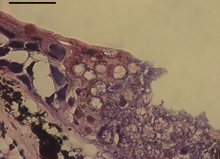Batrachochytrium salamandrivorans
| Batrachochytrium salamandrivorans | |
|---|---|

| |
| Bsal infection in the skin of a fire salamander | |
| Scientific classification | |
| Domain: | Eukaryota |
| Kingdom: | Fungi |
| Division: | Chytridiomycota |
| Class: | Chytridiomycetes |
| Order: | Rhizophydiales |
| Family: | Batrachochytriaceae |
| Genus: | Batrachochytrium |
| Species: | B. salamandrivorans
|
| Binomial name | |
| Batrachochytrium salamandrivorans Martel A., Blooi M., Bossuyt F., Pasmans F. (2013)[1]
| |
Batrachochytrium salamandrivorans (Bsal) is a
It was described in 2013 based on a strain collected from skin tissue of
Another study estimated that this species had diverged from B. dendrobatidis in the
The description of this pathogen and its aggressiveness raised concern in the scientific community and the public, fearing that it might be a rising threat to Western hemisphere salamanders.[9][10] On January 12, 2016, the U.S. government issued a directive that prohibited the importation of salamanders in order to reduce the threat posed by B. salamandrivorans.[11]
Etymology
Batrachochytrium is derived from the Greek words batrachos, "frog", and chytra, "earthen pot" (describing the structure that contains unreleased zoospores); salamandrivorans is from the Greek salamandra, "salamander", and Latin vorans, "eating", which refers to extensive skin destruction and rapid death in infected salamanders.[12]
Susceptible species
The most comprehensive Bsal species susceptibility performed to date has been by Martel et al 2014.[4] Their experiments demonstrated Bsal susceptibility followed a phylogenetic trend with many Salamandridae species being lethally susceptible. Recent work has demonstrated that some lungless species, specifically those in the Spelerpini tribe might also be clinically susceptible to Bsal [13]
Threats to salamanders
Bsal is a serious threat to salamander species, while it has not yet been confirmed in North America,[14] Bsal has had catastrophic effects on certain European salamander populations, believed to be the cause of a 96% decline in populations with in the Netherlands.[15] More than a third of the worlds salamanders live in the United States,[16] and 40% of those salamanders are already threatened.[17] While regulations on the most likely avenue of introduction into North America, amphibian trade,[18] are in place in both Canada and the United States, regulations are seriously lacking in Mexico. Furthermore, Bsal has the potential to infect an estimated 80 to 140 North American salamander species.[19]
Tolerant
This section includes a improve this section by introducing more precise citations. (January 2024) ) |
- Salamandrella keyserlingii
- Siren intermedia
Susceptible
This section includes a improve this section by introducing more precise citations. (January 2024) ) |
- Cynops cyanurus
- Cynops pyrrhogaster
- Paramesotriton deloustali
Lethal
This section includes a improve this section by introducing more precise citations. (January 2024) ) |
- Hydromantes strinatii
- Salamandrina perspicillata
- Salamandra salamandra
- Pleurodeles waltl
- Tylototriton wenxianensis
- Notophthalmus viridescens
- Taricha granulosa
- Euproctus platycephalus
- Lissotriton italicus
- Ichthyosaura alpestris
- Triturus cristatus
- Neurergus crocatus
- Eurycea wilderae
- Pseudotriton ruber
Information sources
More information on Bsal and other diseases impacting amphibian populations, including Batrachochytrium dendrobatidis and Ranavirus can be found at the Southeast Partners in Amphibian and Reptile Conservation disease task team web-page. [1]
References
- ^ PMID 24003137.

- S2CID 52850132.
- PMID 30135150.
- ^ PMID 25359973.
- S2CID 26161581.
- PMID 28287614.
- ISSN 0173-5373.
- PMID 30218076.
- PMID 25359941.
- ^ Rhodi, Lee (2014-10-31). "Skin-eating fungus Batrachochytrium salamandrivorans threatens to wipe out salamanders worldwide". Tech Times. Retrieved 2015-06-05.
- ^ "Listing Salamanders as Injurious Due to Risk of Salamander Chytrid Fungus". U.S. Fish and Wildlife Service. January 12, 2016.
- PMC 4918143.
- .
- PMID 34692807.
- ^ Burke, Katie (6 February 2017). "New Disease Emerges as Threat to Salamanders". American Scientist.
- ^ "Amphibian Species By the Numbers".
- ^ Bishop, David. "Sustaining America's Aquatic Biodiversity, Salamnders Biodiversity and Consevation". Virginia Cooperative Extension.
- S2CID 211266075.
- PMID 37277333. Art. No. 3270.

